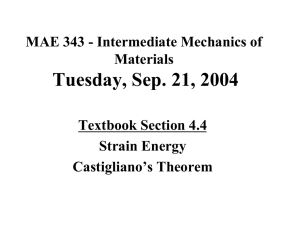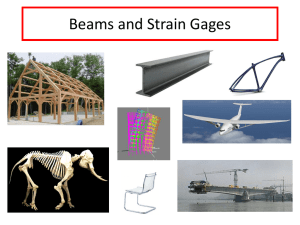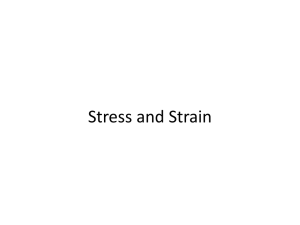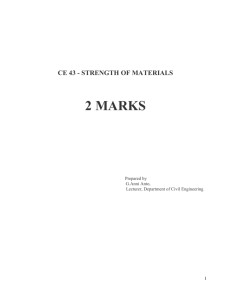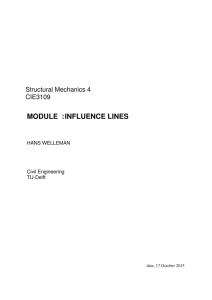Castigliano`s Theorem
advertisement
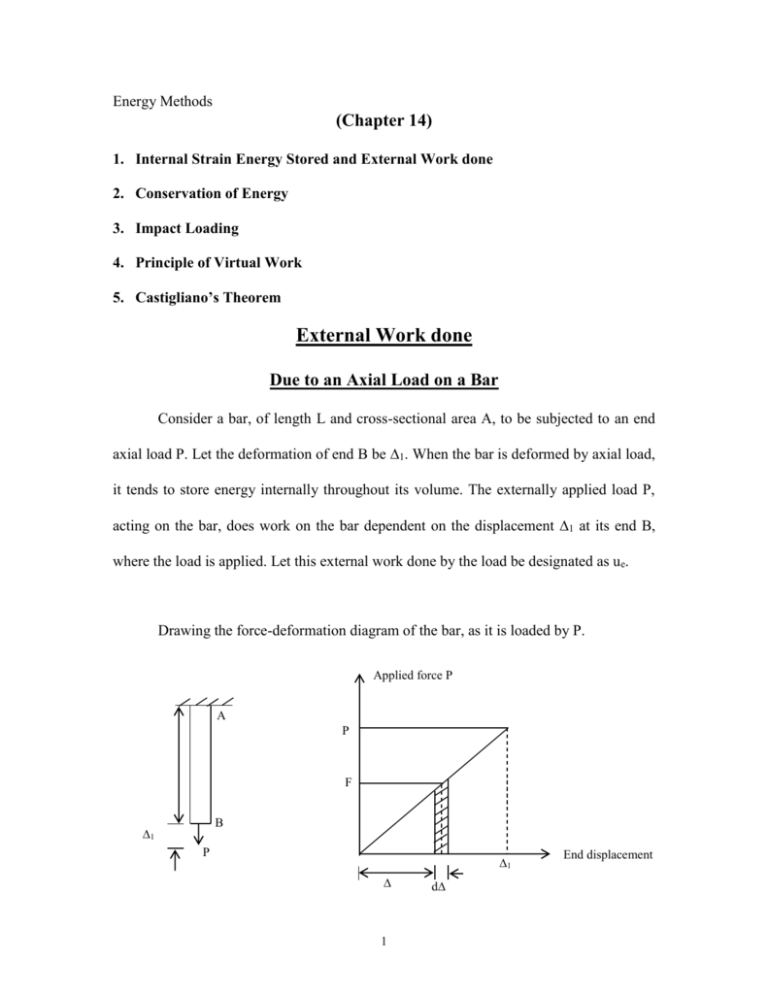
Energy Methods (Chapter 14) 1. Internal Strain Energy Stored and External Work done 2. Conservation of Energy 3. Impact Loading 4. Principle of Virtual Work 5. Castigliano’s Theorem External Work done Due to an Axial Load on a Bar Consider a bar, of length L and cross-sectional area A, to be subjected to an end axial load P. Let the deformation of end B be 1. When the bar is deformed by axial load, it tends to store energy internally throughout its volume. The externally applied load P, acting on the bar, does work on the bar dependent on the displacement 1 at its end B, where the load is applied. Let this external work done by the load be designated as ue. Drawing the force-deformation diagram of the bar, as it is loaded by P. Applied force P A P F B 1 P 1 1 d End displacement 1 ue Fd External work done 0 Since the force versus the end displacement relationship is linear, F at any displacement can be represented by F = k , where k = a constant of proportionality 1 1 0 0 u e Fd k2 kd 2 1 k2 P1 1 , since P k 1 2 2 0 (A) The external work done on the bar by P increases from zero to the maximum as the load P increases from 0 to P (in a linear manner). Therefore the total work done can be represented by the average magnitude of externally applied force (viz., P/2), multiplied by the total displacement 1 (as given by equation (A)). Let an additional load P be applied to the bar after the load P has caused an end extension of 1 at B. Considering the deformation of the end B of the bar due to the application of an additional load P at B, let the additional deformation of the bar be equal to . Applied force Area = P1 A I F E Area = ½ P P L G H J Area = P P 1 B P O C 1 P Area = ½ P1 2 D End displacement The total external work done u e 1 ( P P )( 1 ) 2 1 1 1 1 P 1 P P 1 P 2 2 2 2 Incremental work done on the bar if the load P is applied to the bar resulting in a displacement Incremental work done on the bar when load P was applied at B, initially Considering S OEF and OED, Area of Figure GHIF = Area of Figure CDJH i.e., P1 P 1 1 1 P1 ( P P 1 ) P 2 2 2 1 1 1 P1 ( P P ) P 2 2 2 1 1 P1 P P 2 2 ue Additional work done by P as the bar deforms by an additional Hence when a bar (having a load P acting on it) is subjected to an additional load P, then the work done by (the already acting) P due to the incremental deformation (caused by P) is equal to P. This is similar, to a suddenly applied load P creating an instantaneous deformation , producing an external work of P. 3 Work done due to an end moment M1 A B Let a moment M be applied to end B of the beam AB. Let the rotation at end B be 1 due to M. Since M and gradually increase from zero to 1 (following earlier formulations for an axially loaded bar), Moment 1 U e external work Md M1 0 1 1 M 1 1 2 ________________________________________________________________________ Work done due to the externally applied torque T1 T1 4 Torque T1 1 1 u e Td 0 1 T11 2 Internal Energy Stored (or Internal Work Done) Due to an end axial force The internal strain energy stored in the material is dependent on the amount of stresses and strains created within the volume of the structure. z z z Complementary strain energy Stress dz dy dx y dz z dy Strain x w is the displacement P Z Strain energy dx z 5 The internal strain energy Ui stored within the body is given by U i du i [(average force on element)] (distance moved) 1 z dxdy z d z 2 V 1 z z (dxdydz) 2V dw z dz dw z dz 1 z z dv 2 V 1 z2 dV since z z 2 V 2E E Due to Shear Stresses and Strains z H zydz G zy F E yz zy C D dz y dx A dy B x 1 U i du i zy dydx zy dz 2 Average force on top face, i.e., EFGH distance moved [Force on other faces do not do any work since motion of face ABCD is zero] 6 1 xy zy dxdydz 2 1 xy zy dv 2v xy 1 xy dv since xy 2v G G 2 Due to a bending moment M M y x 2 My 2 I Ui dV dxdydz 2E 2E v V L M2 dx y 2 dA 2 0 2 EI A L 0 “I” - can be constant or varying L M 2I M 2 dx dx 0 2EI 2 EI 2 Due to an axial force 2 N 2 A Ui dV dV 2E 2E V N N 7 2 N dV V 2 2A E L Due to 2 N ( Adx ) 2 2A E L a 2 N dx 2 AE transverse 2 shear y 2 1 VQ Ui dV dAdx 2G 2G It V V V V2 Q2 dx dA 2 2 2GI t 0 A L 2 2 V A Q 2 2 dA dx 2GA I A t 0 z L L 0 f sV 2 dx , 2GA force where f s form factor for shear. Since shear vari es depending on shape of cross - section [See pages 11 and 12 for additional details concerning the form factor fs] Due to a torsional moment T L T Ui V L 0 L 0 2 2G 2 dV T 2GJ 2 V 1 T dV 2G J dAdx 2 T 2J T2 dx 2GJ dx 2GJ 2 8 x Due to Three dimensional Stresses and Strains z 3 yz xz xy yx x 2 y 1 Fig. 14-5 Multi-axial Stresses: The previous development may be expanded to determine the strain energy in a body when it is subjected to a general state of stress, Figure shown above. The strain energies associated with each of the normal and shear stress components can be obtained from Eqs. I and II. Since energy is a scalar, the strain energy in the body is therefore 1 1 1 1 1 1 U i x x y y z z xy xy yz yz xz xz 2 2 2 2 2 2 V (I) The strains can be eliminated by using the generalized form of Hook’s law given by Equations given in Chapter 10. After substituting and combining terms, we have 1 2 1 Ui x2 x2 z2 x y y z x z xy yz2 xz2 2E E 2G V dV (II) where, 9 1 x y z E 1 y y z x E 1 z z x y E x xy yz xy G yz G xz zx G xz G E 2(1 ) If only the principal stresses 1 , 2 , 3 act on the element, as shown in the earlier figure, this equation reduces to a simpler form, namely, 1 Ui 12 22 32 1 2 2 3 1 3 dV 2E E V (14 –14) Recall that we used this equation in Sec. 10.7 as a basis for developing the maximumdistortion-energy theory. ________________________________________________________________________ Using the principle of conservation of energy Internal strain energy stored in the structure due to the applied load = External work done by the applied load. _____________________________________________________________ 10 Appendix to: Effect of Transverse Shear Forces Ur L 1 V 2 ( x) Q 2 ( x, y) dA dx 2 0 G( x) I 2 ( x) A t 2 ( y) (1) To simplify this expression for Ur , let us define a new cross-sectional properties fs, called the form factor for shear. Let f s ( x) A( x) Q 2 ( x, y ) dA I 2 ( x) A t 2 ( y ) (2) (The form factor is a dimensionless number that depends only on the shape of the cross section, so it rarely actually varies with x). Combining Eqs. 1 and 2 we get the following expression for the strain energy due to shear in bending: Ur L 1 f sV 2 dx 2 0 GA (3) The form factor for shear must be evaluated for each shape of cross section. For example, for a rectangular cross section of width b and height h, the expression h Q 2 4 2 b y 2 was obtained in example Problem 6.14 (Chapter 6). Therefore, from Eq. 2 we get 2 bh 1 fs 2 h / 2 2 b 1 3 bh 12 h/2 b h2 6 2 y bdy 5 2 4 (4) The form factor for other cross-sectional shapes is determined in a similar manner. Several of these are listed in Table A, given below. The approximation for an I-section or 11 box section is based on assuming that the shear force is uniformly distributed over the depth of the web(s). Table A: Form Factor fs for shear Section fs Rectangle 6/5 Circle 10/9 Thin tube 2 I-section or box section A/Aweb Impact Problems Using Energy Methods What are impact forces? Suddenly applied forces that act for a short duration of time - Collision of an automobile with a guard rail - Collision of a pile hammer with the pile - Dropping of a weight on to a floor W h t st Plastic impact max Loaded member vibrates till equilibrium is established. 12 Assumptions: 1. At impact, all kinetic energy of striking mass is entirely transferred to the structure. It is transferred as strain energy within the deformable body. U 1 2 1 W 2 mvi v 2 2 g This means that the striking mass should not bounce off the structure and retain some of its kinetic energy. 2. No energy is lost in the form of heat, sound or permanent deformation of the striking mass. Axial Impact of an Elastic Rod m vi L vi = velocity of impact U 2 2 2 V x x x dV dV vol vol i 2E 2E 2E 1 U e 2 mv 2 i Equating Ui = Ue 13 2 Vol 1 x 2 1 E 2 2 mv E i mv E i x x , L L E L x E Vol E x 2 mv , i 2 AL E , x L 2 2 mv E i mv L i AL EA Impact Response of an elastic spring W (m = W/g) h Velocity = vi (just before impact) Static deflection of spring max max W st k 14 W k = spring constant = load per unit deformation max = maximum deflection of spring due to impact = Fe = maximum force in spring during impact k max k 1 1 1 U e U i W (h ) Fe k k 2 2 2 2 1 2W 2Wh i.e., k 2 W Wh 0 2 0 2 k k i.e., 2 2 st 2h st 0 2h st st2 2h st st 1 1 st - -I If we use the velocity at impact as a parameter, just before impact Wh 1 2 1W 2 mvi vi 2 2 g h vi2 2g (II) Substituting in Eqn. (I), st 1 1 vi2 g st (III) Impact Bending of a Beam W h 15 Ue Ui W (h ) 1 Pimpact 2 For a central load, P impact L 3 48 EI 48 EI Pimpact L3 1 48 EI W (h ) 2 L3 24EI 2 L3 24 EI 2 W Wh 0 L3 WL3 WL3 h 0 i.e., 2 24 EI 24 EI Let st WL3 48EI 2 2 st 2 st h 0 st st2 2h st h st 1 1 2 st To find the impact bending stress, Pimpact L c I 4 I 48EI Lc 3 L 4 I max M impactc 16 Virtual Work Method for Deflections (or Deformations) Work-energy method, of equating the external work to internal strain energy, has the disadvantage that normally only the deflection (or deformation) caused by a single force can be obtained. The method of virtual work provides a general procedure to determine the deflections and slopes (or rotations) at any point in the structure (which can be a truss, a beam or frame) subjected a number of loadings. To develop the virtual work method in a general manner, let us consider a body or a structure of arbitrary shape (later this body will be made to represent a specific truss, beam or frame) shown in the figure below. (b) Real Forces (acting on the body) (Internal virtual force) (a) Virtual Forces P2 P1 u L L P u u L P O u A O A B (magnitude = 1) P3 = Deformation at A, along AB, caused by the loads P1, P2 and P3. Let us assume that we want to determine the deflection of a point A, along the line AB, caused by a number of actual (or real) forces P1, P2 and P3 acting on the body, as shown in Figure (b). To find at A, along AB, due to the applied loads (P1, P2 and P3), using the virtual work method, the following procedure could be used. 17 (Internal virtual force) u L P u O A B 1 (unit virtual force) Figure (a) Step 1: Place a virtual force (here we use a unit virtual force) on the body at point A in the same direction AB, along which the deflection is to be found. The term virtual force is used to indicate that the force is an imaginary one and does not exist as part of the real forces. This unit force, however, causes internal virtual forces throughout the body. A typical virtual force (acting on a representative element of the body) is shown in Figure (a). P2 P1 dL u L P u O A B 1 P3 (unit virtual force) Figure b Step 2: Next place the real forces, P1, P2 and P3 on the body [Figure (b)]. These forces cause the point A to deform by an amount along the line AB, while the representative 18 element, of length L, now deforms by an amount dL. As these deformations occur within the body, the external unit virtual force (already acting on the body before P 1, P2 and P3 are applied) moves through the displacement ; similarly the internal virtual force u acting on the element (before P1, P2 and P3 are applied) moves through the displacement dL. These forces, moving through displacements and dL, do work. Step 3: The external virtual unit force, moving through displacement , performs external virtual work given as (1) times (), on the body. Similarly, the internal virtual force u, moving through displacement dL, performs internal virtual work given as (u) times (dL). Since the external virtual work is equal to the internal virtual work done on all elements making up the body, we express the virtual work equation as: Virtual forces 1 (u dL) (A) Real deformations The summation sign, in Eqn. (A), indicates that all the internal virtual work in the whole body must be included. Eqn. (A) gives the deflection along the line of action of unit virtual force. A positive value for indicates that the deflection is in the same direction as the unit force. In writing down Eqn. (A), one has to remember that the full values of the virtual forces (unit force at A, and all the internal forces, ui) were already acting on the body when the real forces were applied (viz. P1, P2 and P3). Therefore, no one-half appears in any term of Eqn. (A). 19 In a similar manner, the rotation (or slope) at a point in a body can be determined by applying a virtual unit moment or couple (instead of a unit force) at the point where the rotation is desired (see Figure below). P2 (Internal virtual force) P1 u dL L P u u L P O u A O A B 1 (Virtual unit moment) P3 (a) Virtual unit moment applied (b) Real forces P1, P2 and P3 applied (Develop virtual force u, within (Virtual unit moment rotates through an angle ) the body) Virtual unit moment Virtual internal forces 1 um dL Real slope (B) Real deformation 20 Specific Structures Trusses (i) Subjected to applied external loads only If ui represents the internal forces developed in the members, due to an applied unit load (at the point where the deformation is to obtained) in the required direction, then Eqn. (A) can be expressed as 1 ui Pi Li (C) Ai Ei (ii) For trusses subjected to a temperature change (causing internal forces) The incremental deformation caused in member due to a temperature rise is dL, where dL T L Also n 1 u i i Ti Li (D) i 1 Temperature change (iii) Trusses with Fabrication Errors n 1 u i Li (E) i 1 where 21 L = difference in length of the member from its intended length, caused by a fabrication error. Beams For loads acting on a beam subjected to bending moments alone, the deformation , at a given point along a given direction is given by 1 mMdx (F) EI where m is the bending moment in the member when a unit load is applied on the structure at the specified point in the specified direction. For a general loading on the beam, generating axial, shear, bending and torsional forces/moments in the beam 1 nN dx mM dx AE EI f s vV tT dx dx GA GJ (G) where n is the axial force generated in the beam when a unit load is applied on the beam in the required direction; similarly m, v and t are the bending moment, shear force and torsional moment generated under the applied unit load. Consider a truss subjected to loads F1, F2 and F3 D C B A 1 Unit virtual load is applied in the direction in which the deflection is required, say at B in the vertical direction. Let uAB, uBC, uCA and uCD be the internal forces generated when the unit load is applied at B. 22 D F1 C B F2 A F3 Let PAB, PBC, PCA and PCD be the internal forces generated in the truss members due to the given loads F1, F2 and F3 acting on the beam. Then the vertical deflection at B is obtained as, n ui Pi Li i 1 Ai Ei v B (H) Considering a Beam Subjected to Bending Loads P1, P2 and P3 B A C L/2 L Let us say that it is required to find the vertical deflection at C due to the given loads. (i) Apply a unit vertical load (virtual) at C in the vertical direction and find the moment m in the beam. (ii) Then apply the given loads on the beam (say P 1, P2 and P3) and compute the bending moments M in the beam. Then the deflection v at C is obtained 23 P1 P2 A P3 C B L/2 L vC mMdx EI (I) Castigliano’s Theorem (Based on the strain energy stored in a body) Consider a beam AB subjected to loads P1 and P2, acting at points B1 and B2 , respectively. P1 P2 B1 B2 v2 v1 P1 = B2 B1 v21 v11 + P1 P2 v22 v12 24 v1 v11 v12 v 2 v 21 v 22 If f11P1 v11 , and where f11 = deflection at B1 due to a unit load at B1 f 21 P1 v21 with f21 = deflection at B2 due to a unit load at B1 and v22 f 22 P2 , with f22 = deflection at B2 due to a unit load at B2 & v12 f12 P2 , with f12 = deflection at B1 due to a unit load at B2. Then v1 v11 v12 f11 P1 f12 P2 (I) Similarly, v 2 v 21 v 22 f 21 P1 f 22 P2 (II) Considering the work done = Ui 1 1 P1v11 P2 v 22 P1v12 2 2 1 1 P1 f11 P1 P2 f 22 P2 P1 f12 P2 2 2 1 1 f11 P12 f 22 P22 f12 P1 P2 2 2 (III) Now we reverse the order the application of loads P1 and P2, viz., applying P2 at B2 first and then applying P1 at B1, 25 P1 P2 B1 B2 v2 v1 = B1 P2 B2 v22 v12 + P1 P2 v21 v11 v1 v12 v11 f12 P2 f11P1 Similarly, v2 v22 v21 f 22 P2 f 21P1 Ui = 1 1 P2 v 22 P2 v 21 P1v11 2 2 1 1 P2 f 22 P2 P2 f 21 P1 P1 f11 P1 2 2 1 1 f 22 P22 f 21 P1 P2 f11 P12 2 2 (IV) Considering equation (III) and (IV), and equating them, it can be shown that 26 1 1 f11 P12 f 22 P22 f 12 P1 P2 2 2 1 1 f 22 P22 f 21 P1 P2 f 11 P12 2 2 Ui f12 f 21 This is called Betti – Maxwell’s reciprocal theorem 1 B1 B2 f21 1 B1 B2 f22 f12 Deflection at B2 due to a unit load at P1 is equal to the deflection at B1 due to a unit load at P2. From Eqn. (III) U i f11 P1 f12 P2 v1 P1 From Eqn. (IV) U i f 22 P2 f 21 P1 v2 P2 This is Castigliano’s first theorem. Similarly the energy Ui can be express in terms of spring stiffnesses k11, k12 (or k21), & k22 and deflections v1 and v2; then it can be shown that U i P1 v1 U i P2 v 2 27 This is Castigliano’s second theorem. When rotations are to be determined, v i M i 28


